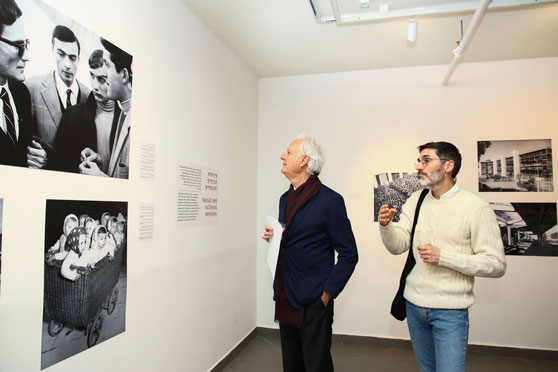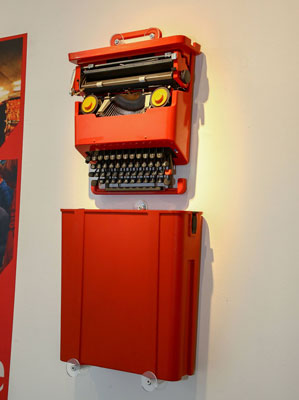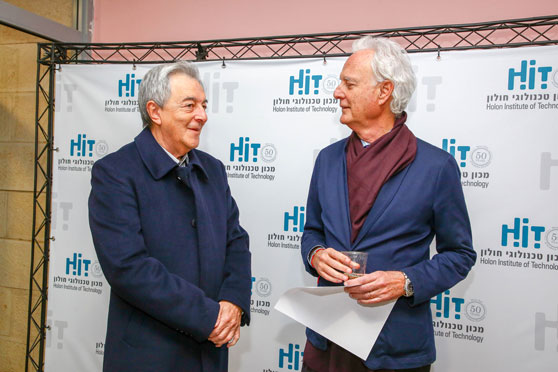More:
News & Stories
Remember the typewriter?
A bold new exhibition demonstrates that letters are only part of the Olivetti package

From the right: Evri Baumgarten and Sergio Brabanti | Photo: Ofer Amram
For years, Olivetti" was the brand most associated with the typewriter.
A new exhibition which opened at the Julia Mizrahi “Vitrina Gallery” at HIT reveals many other aspects about the brand which has made it legendary. In addition to the ubiquitous typewriter, Olivetti was also known as a leading Italian technological industrial company which revolutionized the fields of product design, architecture and advertising, thanks to its innovative approach to inclusive design.
Although the typewriter has long passed from the world and is now something relegated to museum displays, Olivetti's legacy is alive and kicking- technology start-ups and leading computing companies worldwide nowadays follow Olivetti's model of combining design and production with industrial architecture, creating work environments, branding, and global flagship stores.
Olivetti changed the way the idea of a "brand" is perceived, produced, and consumed to this day.

Valentine Typewriter | Photo: Ofer Amram
At the exhibition, presented for the first time in Israel, a selection of Olivetti's iconic typewriters is on display, alongside calculators and even the company's first computers.
Among the exhibits: a number of portable typewriters, such as the MP1, the first portable typewriter produced by the company in 1932 designed by Aldo and Adriano Magnelli. Also on display is the iconic Lettera 22 designed by Marcello Nizzoli, which entered the permanent collections of the Museum of Modern Art in New York and won the Compasso d'Oro award in 1954. The sophisticated typewriter became one of the symbols of the new and renewed post-war Italy.
Another portable typewriter exhibited is the red "Valentine", produced in 1969, designed by Ettore Sottsas, a brand new typewriter invented for use anywhere but the office. An example of Valentine is on display in the permanent design collection at the Museum of Modern Art in New York.

From the right: Dr. Dalia Menor, Mr. Sergio Brabanti, Prof. Eduard Yakubov, Dr. Maria Sika | Photo: Ofer Amram
Olivetti's first calculators are included in the exhibition, including the Summa 19, the first of its kind. The Summa was designed almost as a toy, as a “pop” object, bypassing the idea of an advanced and luxurious technological device in favor of a mass-produced product. Its three-dimensional presence is minimalistic, all black, with a broad band of bright and shiny green. The keys also reflect the “pop” approach - large, unstylish keys, simple in volume and more reminiscent of chocolate cubes. The model won the Compasso d'Oro award in 1970.
As part of the historical retrospective, the exhibition also follows the development of the Olivetti logo, various fonts designed for the typewriters, including Hebrew, and historical photographs of Olivetti's flagship stores.
The exhibition illustrates the cultural and social way of life enjoyed by the company's employees in the industrial city of Ivrea in northern Italy - the city that was chosen in 2018 as a UNESCO heritage site as an "industrial city of the 20th century".

From the right: Mr. Sergio Brabanti and Prof. Eduard Yakubov | Photo: Ofer Amram
The exhibition shows examples of the innovative advertising approach and graphic design of the company, that includes posters, ads and advertising videos.
Among these posters is one from 1920’s which shows the typewriter "riding" on a rail and overpassing the train - the most popular symbol of speed and power at the time. "The Typist", a poster by designer Marcello Dudovic from 1928, presents a new breed of woman in the workplace, a persona examined through the magnifying glass of contemporary literature.
The exhibition is the fruit of a collaboration between the Vitrina Gallery, the Olivetti Archive in Ivrea, the Italian Embassy in Israel, and the Italian Cultural Institute in Tel Aviv.
The festive opening event took place in the presence of the President of HIT, Prof. Eduard Yakubov, the Italian Ambassador to Israel, Mr. Sergio Brabanti, senior officials from the Italian Institute of Culture and many guests.
The visitors were greeted by the performance "Writer A", with Amir Harash and Amir Atzmon, who printed personal letters for the audience on a typewriter.
Exhibition Curator: Ivry Baumgarten,
Vitrina Gallery Chief Curator: Dr. Dalia Manor
The exhibition is presented at the Julia Mizrahi Vitrina Gallery
Building 6 (Faculty of Design)
Sunday - Thursday | 10:00 - 17:00
Friday: 10:00-14:00
Exhibition closing 2.5.2023
- News & Events
International Week of Interdisciplinary Studies and Academic Collaborations in Crete
A substantial delegation of 16 students and four faculty members from HIT Holon Institute of Technology participated in week-long international activities and events at HMU-Hellenic Mediterranean University in Crete. ...


 Additional programs
Additional programs
